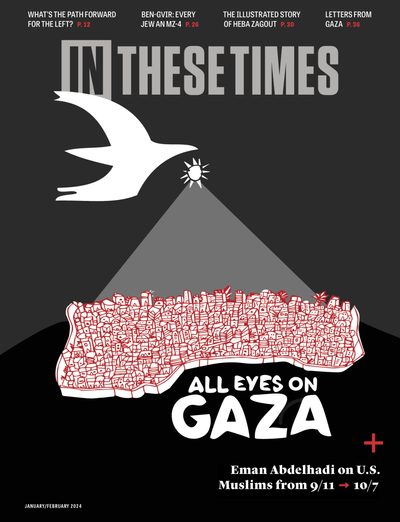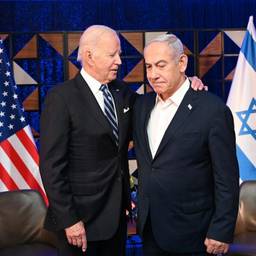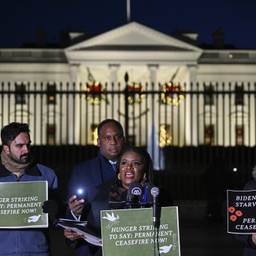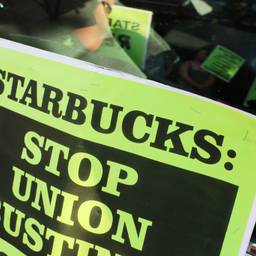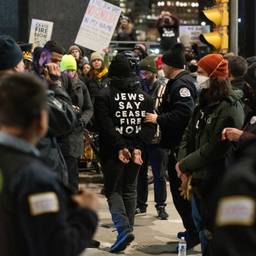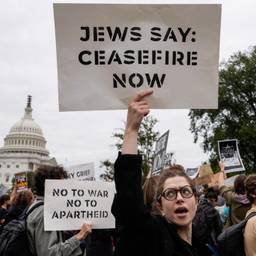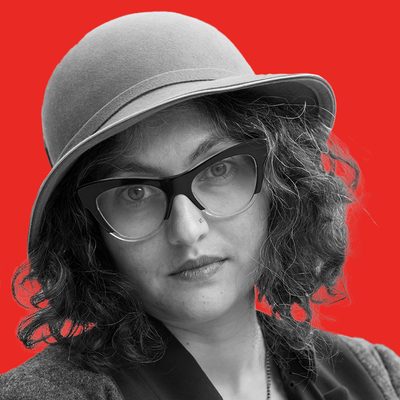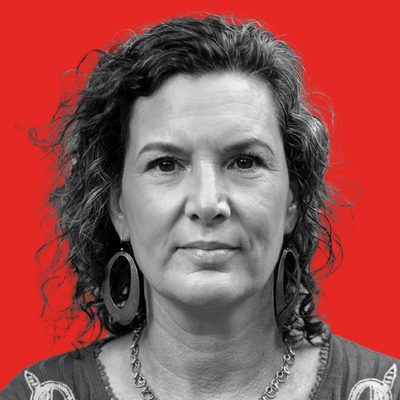Don’t Let the Flailing Center Box Out the Left’s Powerful Possibilities
Public fractures within Jewish communities provoked by Gaza genocide offer lessons—and paths forward—for progressives, Jewish and not.
Dania Rajendra and Rebecca Vilkomerson
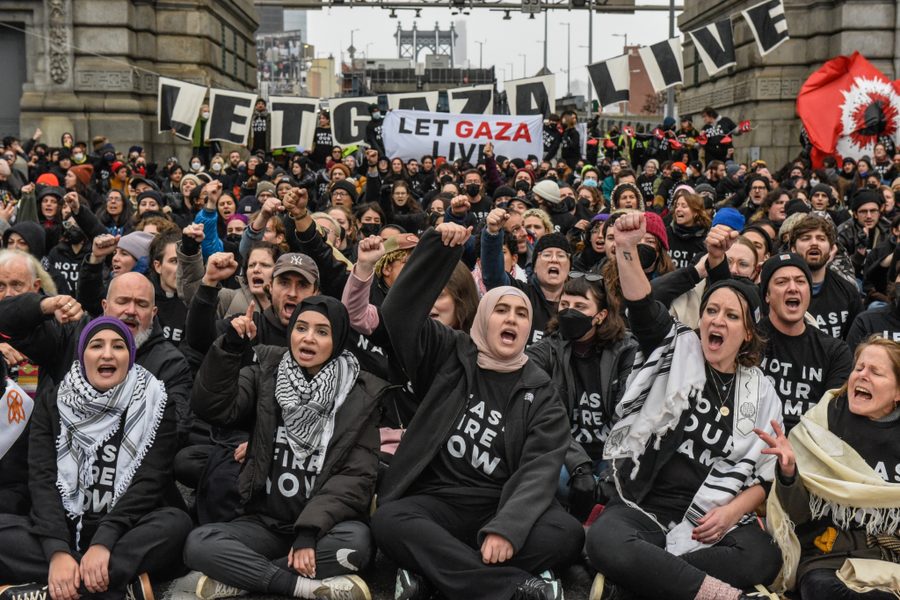
Antiwar activists in New York, including those with Jewish Voice for Peace, blocked the Manhattan Bridge on November 26, 2023, to demand a cease-fire in Gaza. The sign in the background reads "LET GAZA LIVE." Photo by Stephanie Keith/Getty Images
This article is being co-published with Truthout.
As Israel ratcheted up the destruction of Gaza over the last two months, the news of the genocide itself has competed with the relentless coverage of the political divisions at elite institutions and among Jews. Meanwhile, in Queens, N.Y., far from the spotlight, working-class Muslims (joined by their Jewish, Christian, Sikh, Korean and Hindu neighbors) continued their weekly protests at the office of Rep. Grace Meng (D-N.Y.), who has not yet called for a cease-fire despite representing one of the most Muslim congressional districts in the United States.
Similar solidarity was seen at Columbia University after the administration disbanded student chapters of Jewish Voice for Peace and Students for Justice in Palestine. In response, more than 80 multiracial and multiethnic student groups coalesced to support these chapters and continue their antiwar efforts. Thousands of Columbia alumni signed a petition decrying the administration’s action shortly after a “doxxing truck” targeted pro-cease-fire students and prompted a response from students across the political divide. For the first time, professors formed a Faculty for Justice in Palestine group.
Both efforts — outside Meng’s office and at Columbia — offer critical and hopeful lessons for all leftists.
The genocide of Palestinians is happening in real time, and the Left must continue to press for an immediate cease-fire as the first step toward Palestinian freedom. The enormous, growing grassroots movement which has emerged since October 7 presents a powerful counter-model to ethnonationalism: a participatory, multi-ethnic society demanding democratic representation. The insistent view that Jews are alone and uniquely vulnerable in both the United States and throughout the world — which is coming from mainstream media and legacy Jewish institutions — clouds real opportunities for Jews on the Left — and the Left as a whole.
More than 85% of the population of Gaza has been displaced. About 20,000 Palestinians have been killed, and more than half of those who have died — 10,000 — are reportedly children. Israel has deliberately destroyed hospitals, schools, mosques, flour mills, news offices, refugee camps and United Nations facilities in what is clearly an attempt to obliterate what little infrastructure made Gaza (just barely) livable through 16 previous years of siege.
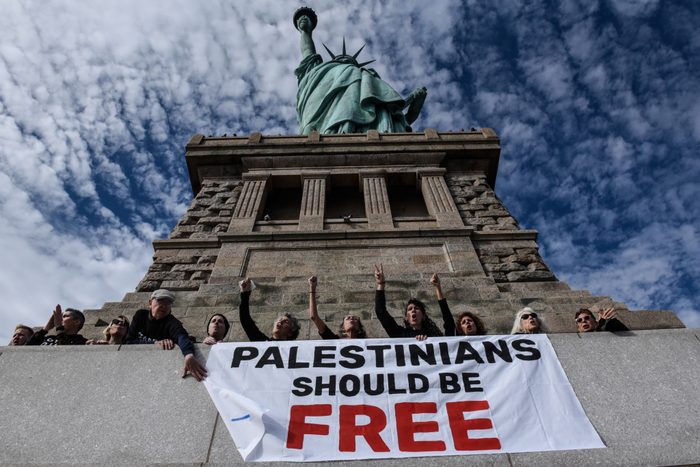
The resulting polarization among American Jews and in our institutions illuminates the dynamics also playing out across non-Jewish communities in the United States. In the broadest sense, the divide is between those organizations that support the assault on Gaza (and largely accept the mass deaths of civilians as part of the war project) and those who don’t.
The pro-war organizations like AIPAC and the Anti-Defamation League (ADL) are undemocratic legacy Jewish institutions that actively oppose calls for cease-fire, politically and culturally support the war and Israel’s far-right government, and viciously police the use of terms like genocide and ethnic cleansing as attacks on the Jewish people.
The Jewish organizations on the Left, in partnership with Palestinian, Arab and other groups mostly led by people of color, meanwhile, have unequivocally called for a cease-fire and for the United States to stop sending billions in unconditional military aid to Israel.
In the confounding middle are people and groups that identify as centrists and liberal Zionists. Their public demands are generally limited to minimizing civilian casualties and freeing the hostages (usually with no parallel demand of freedom for Palestinians languishing in Israeli jails, even children). Together with those that oppose a cease-fire, they perpetually reference Hamas’s war crimes on October 7 to avoid confronting the catastrophe in Gaza and to assert that Jews are isolated, besieged by all sides.
One example of this brand of false isolation and fearmongering discourse comes from liberal comedian Amy Schumer, who, in the wake of October 7, posted a widespread meme that ended with, “But I stood alone, because I am a Jew.” The conceit is, of course, ludicrous. Neither American Jews nor Israeli Jews are alone: President Joe Biden quickly flew to hug Israeli Prime Minister Benjamin Netanyahu after the Hamas attack, nearly every Global North government expressed solidarity with Israel, and Congress passed a resolution supporting Israel while placing the blame for Palestinian deaths on Hamas and then went about working to send billions in aid (and providing an unending stockpile of weapons) to Israel. Schumer’s meme also reinforces the canard promulgated since the 2017 Women’s March that Jews are somehow unwelcome on the Left.

All this makes it understandable why we Leftists find it difficult to resist arguing about reality with so many prominent people, media outlets and institutions. They’re working from a shared, well-established script to impose limits on the use of language and the contours of public discourse. Those constraints include vociferous objections to phrases like “From the river to the sea” and the repeated, required insistence on the condemnation and repeated disavowals of Hamas before permitting any mention of Israel’s ongoing apartheid against Palestinians.
Those limits are on display in the super-charged effort to conflate antisemitism with criticisms of Israel, painting nearly every challenge to Israel’s attacks on Gaza as antisemitic — from universities banning student groups to employers firing workers for pro-Palestine tweets to Congressional censure to the shameful House resolution, passed in early December, equating anti-Zionism with antisemitism.
Centrist and right-wing institutions, both Jewish and Christian, continue to construe the widespread opposition to Israeli violence as a threat, rather than as evidence of a well-functioning pluralistic society (with plenty of room for Jews of any opinion). Promoting this view is having profound effects on individuals. A friend recently recounted a story about a Shabbat dinner with his mom and sister, who belong to the Modern Orthodox community he has since left. That night, his family members predicted that at least half of their community will leave their homes in the United States for Israel by the spring because, he says, they feel they will be safer in Israel than in their affluent New Jersey suburb.
This anecdote illustrates the expectation, expressed by many American Jews, that antisemitic hordes are poised to descend on their doorsteps. Antisemitic threats against synagogues and Jewish institutions have, distressingly, risen since October 7. These incidents are conflated with Zionists’ discomfort with protesters chanting phrases like “Let Gaza Live” and “Free Palestine,” which they interpret as a genocidal threat rather than a humanistic plea. The conflation of actual antisemitic threats with the lurid news coverage of incidents that are neither antisemitic nor threatening as such is shaping a widespread perception that is out of sync with reality. The inability to distinguish “safe” from “comfortable” speaks to the disconnect between facts and the communal emotional state stoked by the misinformation and disinformation spreading through social media feeds, legacy Jewish institutions and the Israeli government — perhaps most apparent in the misdirecting refrain that “October 7 is the largest massacre of Jews since the Holocaust.”
The “largest massacre of Jews” line intentionally triggers a powerful and traumatic sense of vulnerability and victimization. It evokes a history when Jews suffered a genocide as a minority in Europe to entirely invert the current vast power asymmetry between Israel (a nuclear power with one of the largest armies in the world and the overwhelming backing of the Global North) and the stateless Palestinians (who have endured 75 years of land left, poverty, occupation, dehumanization and apartheid).
This deliberate formulation — the connection of this moment with the still-electric third rail of the failure of U.S. and European societies to save millions of Jews and others during the Holocaust — serves not only to obfuscate the systematic war crimes Israel has been committing against Palestinians since 1948, but to drive such fear to the point that war crimes are not only acceptable, but justified (even expected). It’s a similar power dynamic to former president Donald Trump’s 2016 appeal — based on amped-up white resentment, imagined Christian persecution, anti-Asian and anti-Jewish conspiracy theories, and undisguised racism and misogyny — which has now become the norm from Freedom Caucus members and their allies. It serves to justify vigilante violence, police murder and despicable border policies, many of which — like Israel’s genocide of Palestinians—violate international law.
The “massacre” line seeks to conflate Hamas with the Nazis. This is specious. The Nazis used German military and police — the state apparatus — to displace and kill thousands of people as they took over country after country. Hamas, whatever its varied and contradictory statements about Jews as a whole, is not the global power Israel is. Israel’s state apparatus keeps Palestinians inside Gaza, imprisoned and besieged. The Hamas attack was not an antisemitic act. Hamas targeted Israelis as oppressors of their people, not as Jews. In fact, non-Jews number substantially among the killed and captured. This distinction does not excuse attacks on civilians, but failing to acknowledge the fundamental difference between the massacres of the Holocaust and the October 7 attacks is a bad-faith argument.
The legacy Jewish institutions and lawmakers parroting this refrain and fostering waves of Holocaust metaphors and concerns about antisemitism on college campuses have created a self-fulfilling antisemitism feedback loop. The loop is designed to use fears of a rising tide of anti-Jewish violence and non-existant structural discrimination to concentrate attention on Zionists’ feelings of vulnerability, which boxes everyone else out of the discourse and advances the conflation of antisemitism and anti-Zionism.
Centrists and right-wingers promulgate this rhetoric knowing the contemporary United States is the most welcoming and safe country for Jews in modern history, especially compared with Europe, despite the increase in interpersonal anti-Jewish incidents since October 7. The damage of allowing this feedback loop to continue unchallenged is evident in the near-total silence about the doxxing, firing, rescinding of job offers, assaults and even murders that Palestinians and allies are facing in the United States. (Notably, no one is asking university presidents about school policies regarding the calls on campus for the genocide of Palestinians.)
The ADL, leading the charge to conflate antisemitism with anti-Zionism, has been classifying actions — including Jewish-led protests — for cease-fire since October 7 as part of the swell of antisemitism. The ADL is also targeting Palestinian and multiracial groups as antisemitic for speaking out against Israel’s genocide, while at the same time, the ADL’s top official has excused Elon Musk’s antisemitism. This mirrors the same inversion of power embedded in the massacre refrain, that is, outspoken students are somehow more dangerous to world democracy and Jews than the owner of a primary global communications channel (who is also the richest person on the planet).
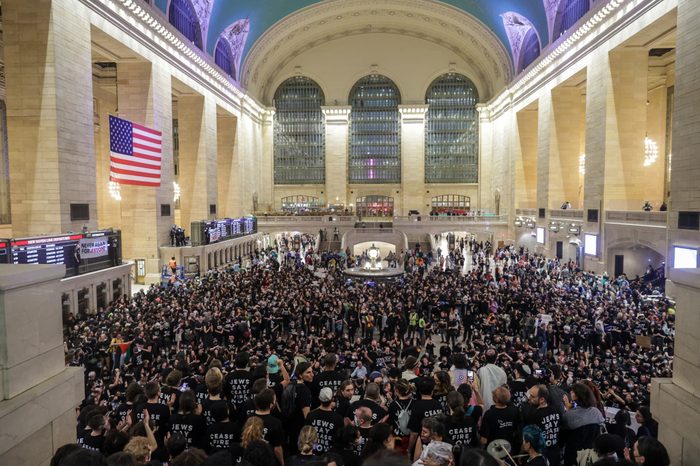
Institutions like the ADL claim ownership of representing Jewish communities; the ADL in particular is the only group tracking antisemitism across the country at such a large scale. It also claims to be a civil rights organization despite a long history of close partnerships with law enforcement, ongoing spying on movement organizations and an unrelentingly right-wing approach to Israel, as well as on issues like abolition and racial justice.
The ADL is just one of many American Jewish legacy institutions — several including the ADL, AIPAC and the Jewish Federations of North America are involved in the new 10/7 project—pushing narratives that focus on fear, danger and a state of existential crisis as a means for conflating antisemitism and anti-Zionism. They’re joined in this effort by Christians United for Israel (CUFI), the Christian Action Network and others. Long before October 7, their shared reactionary political agenda — to limit the potential and possibilities for new social and political horizons for Jews and non-Jews alike — drove this strategy. Now, this serves the reprehensible purpose of distracting — or worse, excusing — Jewish Americans from grappling with the ethnic cleansing and genocide happening in our name.
Decades of concerted right-wing efforts to redefine antisemitism have criminalized criticisms of the State of Israel as criticisms of the Jewish people, positioning the State of Israel as exempt from the critique that all states can and must be subject to. This decades-old campaign to conflate Israel with world Jewry remains contested, but has tragically been all too successful.
The resulting centrist American Jewish discourse is what happens when a too-insular community, connected to a foreign ethnonationalist project, is defined by unrepresentative institutions with artificially constrained political horizons in a country already consumed by its own exceptionalism.
Most American Jewish legacy institutions, synagogues, Hebrew schools and summer camps teach little or nothing about the living conditions of Palestinians or the violent history of the founding of the State of Israel. When it comes to genocides, most teach only about the Holocaust and pogroms. This deficiency leaves many American Jews ignorant of basic world history and unprepared to make connections of mutual solidarity with the large number of communities that have also survived genocides (which are, of course, mostly people of color).
The U.S. educational system, when it teaches about historical world genocides, usually also fails to connect them with genocidal chattel slavery and colonialism. Right now, the U.S. public is awash in the details of the October 7 attacks against Israel, but is left with barely any coverage of other genocides currently underway, including Armenians in Azerbaijan, Rohingya in Myanmar, and Dafuri ethnic groups in Sudan.
For American Jews, the perceived (and false) isolation and exceptionalism also obscures the domestic consequences of the tactical alliance of Jewish and Christian Zionists. More Christian Zionists live in the United States than Jews of all political positions. Christian Zionism is part and parcel of far-right, white Christian nationalist politics, and it is these Christian Zionists who pose the most immediate danger to the ability of Jews and others to be freely and fully non-Christian in the United States. It is their institutions and their political influence that restrict our rights to abortion and reproductive care, that try to force (their) prayer into schools and other public spaces, that help lead the attacks on trans youth and communities and oppose worker protections and institutions. It is also their leaders and institutions that promote antisemitic, anti-Muslim conspiracy theories (like the one Musk approvingly tweeted about), which are often cited by the far-right white men — many with ideological ties to white supremacist organizations — who have perpetrated the vast majority of the antisemitic, anti-Muslim, anti-Hindu and anti-Sikh violence since 9/11 (including shootings at the the Oak Creek gurdwara in Wisconsin in 2012, the Tree of Life Congregation in Pittsburgh in 2018, and of the three Palestinian students in Vermont in November 2023).
The vast majority of Jewish voters, like most non-Jewish voters, oppose Christian nationalist policies and reject the conspiracy theories that underpin them. Centrist Jewish institutions exploit Jewish commitments to Israel to push Jewish voters and donors to support far-right politicians whose overall agenda most Jews oppose (and whose only qualification is support for Israel). Whether at the behest of donors or leadership, the political priorities of many legacy organizations simply don’t match those of so many of their constituents.
This mismatch was undeniably on display at the March for Israel in Washington. A crowd of Jewish school children and leaders, including prominent liberal Zionists, cheered featured speaker John Hagee; Hagee is the evangelical, Christian Zionist and antisemitic leader of CUFI, who has claimed “God sent Hitler.” (The crowd booed Van Jones and shouted “no cease-fire” during his call for an end to the violence.)
While this state of affairs is frankly heartbreaking, there is nevertheless an opportunity for the Left — Jewish and non-Jewish — to contend with the fundamentally anti-democratic nature of both elected and community leaders’ continued support for Israel as it perpetuates genocide. Particularly for those of us who are not white and Christian, it highlights the need to build the democratic cultural, educational and spiritual institutions we all need to support a sustained and flourishing intergenerational movement, inside and outside of our communities.
For decades, legacy Jewish institutions — religious and secular alike—have shrunk as they refused to include (or actively excluded) wide swaths of the Jewish community, such as pro-Palestinian leftists, queers, Jews of color and intermarried families. Over that time, Jews have been voting with our feet, and these institutions’ claims of representation are assertions not backed by membership. Whether at the behest of donors or leadership, the political priorities of many legacy organizations simply don’t match those of their supposed constituents.
Jews are, of course, not the only ones wrestling with this problem of undemocratic institutions. In the most obvious example, both the Republican and Democratic parties continue steadfast support for Israel and its war machine despite the overwhelming popularity of a permanent cease-fire among voters and prospective voters. Nonetheless, we see ongoing handwringing over whether calling for a cease-fire is alienating centrist Jews and is unnecessarily divisive — claims that usually raise the specter of a second Trump administration.

That scare tactic isn’t working. A cease-fire may be the only thing most U.S. voters actually agree on right now. Some 77% of Democrats and 58% of Republicans support a cease-fire, according to polling cited in The Hill. A more recent New York Times/Siena poll found voters of any party (or none) believe Israel should stop its military campaign by more than 5%. Democrats depend on, among others, young voters and Muslim voters to win states like Michigan and Minnesota (especially as Republicans make inroads among communities of color). Those voters are much more numerous than the centrist Zionists who might vote for Biden, as most American Zionists are conservative Christians and firmly entrenched in the Republican party.
Leading Democrats and self-proclaimed Jewish leaders nonetheless warn against alienating that same sliver of constituents, which is the very definition of an anti-democratic impulse. Frankly, the no-cease-fire position jeopardizes Biden’s already precarious re-election chances in 2024.
Infusing community institutions with real democratic representation is a core value of the Left, and it must be a priority for our social, racial and economic justice movements. If Jews and non-Jews alike can turn toward the huge, worldwide, multiethnic and multiracial demonstrations happening in support of Palestinians — rather than looking to the recalcitrant center and getting stuck in the feedback loop — then we would see glimmers of the participatory, multiracial society Leftists want to see.
As an alternative to legacy Jewish institutions, groups like Jewish Voice for Peace (JVP) and Jews for Economic & Racial Justice (JFREJ), among others, have for decades been building and engaging in solidarity politics that are effective and nourishing. Lessons from these decades include the necessity of building cross-movement and intergenerational connections; strong relationships; disagreement without compromising alignment; wide representation and inclusion; and years of acting in solidarity across differences of faith, class, race and gender (without flattening any of them). These lessons are especially critical now and are on display and in action in many places.
In fact, these solidarity politics might be the only thing that actually works.
To strengthen our solidarity with others, many Leftist Jews are digging deeper into our specific cultural inheritance. Left Jewish organizations have galvanized our grief into calls for a cease-fire with intensity and determination, centering the core Jewish principle that “to save one life is to save the world.” Many Jews on the Left are relying on — and sharing — Jewish teachings, traditions and ethics to transmute some of our sorrow and horror into hope and courage through new formations like Rabbis4Ceasefire. JVP, the only major Jewish anti-Zionist organization, has led train station takeovers all over the country, shut down bridges and highways in many major U.S. cities, and led high-profile actions in New York City (the most Jewish place in the United States) by occupying Liberty Island and Grand Central Station.
We have also seen so many Jews show up in solidarity with people across race and religion, taking action with neighbors to hold pro-war elected officials accountable and to support the elected leaders displaying courage by speaking out against the genocide. These acts of unity and solidarity contrast sharply with the artificial isolation we see in memes and messages perpetuated by legacy institutions, which for too long defined Judaism in the public sphere. For many of us, it’s not only that the situation in Gaza demands solidarity and action. It’s that Judaism does too.
Judaism, with all of its reverence for words, also emphasizes practice. As mourners, we have found that the Jewish practice of shiva holds great practical wisdom on moving from feelings to facts, reaction to response. During the first seven days after a death, known as shiva, a mourner remains at home and the community supports them by visiting with food and helping out, up to and including taking out the trash. At shiva’s end, the mourner symbolically leaves their house and, often with some company, walks around the block to reintegrate into the world and its realities. Both shiva and its ritual end offer a counter to the isolation that grief often provokes.
Unlike during the Iraq War, when solidarity with Palestinians was itself one of the fissures that broke the antiwar movement, the new, stronger antiwar formation now puts commitment to Palestinian freedom at its center. There is space for everyone, including Jews, to participate. This practice is undeniable and deeply hopeful, and it builds on the multiracial Left’s involvement in the massive racial justice demonstrations of 2014 and 2020, spurred by the Movement for Black Lives (M4BL), the Women’s March in 2017 and the Muslim Ban protests that same year.

The Rising Majority — which includes organizations from M4BL to SURJ (Showing Up for Racial Justice) to AROC (the Arab Resource and Organizing Center) to JVP — is leading the way in showing how a Black-led, multiracial Left can strengthen and thrive by being unequivocal in its internationalist commitments and political clarity. Concurrently, we see union members building pressure for cease-fire — and both local and national unions increasingly calling for it. Nurses, teachers, Starbucks workers, postal workers, autoworkers and electrical and machine workers have all taken action.
Some calls came from top union leadership, like outspoken anti-Zionist Jew Mark Dimondstein (president of the American Postal Workers Union) and Brandon Mancilla (member of the first directly elected executive board of the United Auto Workers). The UAW is one of the nation’s largest unions and announced, along with its cease-fire position, a noteworthy move toward exploring divestment not just from Israel but the war machine more generally.
Other national unions were pushed into position by the actions of union locals and the swell of rank-and-file members. American Federation of Teachers locals — including the Chicago Teachers Union — endorsed calls for cease-fire, which reportedly helped push the national union president, Randi Weingarten (a well-known Israel stalwart), to improve her public position.
Despite the previously mentioned blacklisting and other pressure — such as Starbucks suing the union over their solidarity statement — workers are speaking out against their employers’ (and sometimes their unions’) commitments to Israel. These examples don’t comprise the entirety of labor’s response, but they do represent a significant shift away from labor’s much more unified, hawkish official positions during Israel’s bombardments of Palestinians in 2002 and 2014.
This shift has many causes, first and foremost the scale of the devastation in Gaza and the brutality of the violence. It also matters that the U.S. labor movement itself has become less insular.
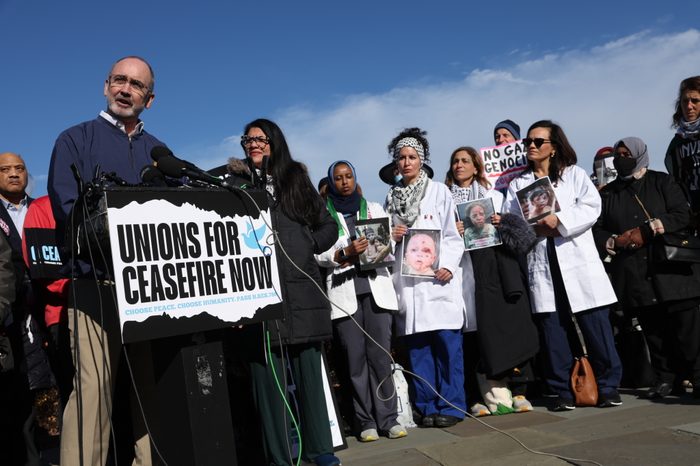
Consider, for example, how new labor organizing (at Starbucks and Amazon), new labor democracy (the United Auto Workers), new labor militancy (the unions of actors, writers, flight attendants) and longstanding internationalist union solidarity (the United Electrical Workers) have forged new (or renewed) connections with movements since 2014. That’s when racial justice organizing began to force needed conflicts and reckonings to labor’s surface. The shift is also the result of a decade of teachers’ strikes and Trump-era labor resistance actions, such as organizing around the Muslim Ban, the Taxi Workers Alliance strike, the Google walkouts and climate fights (Amazon walkouts). These concerted actions and new organizing (often originating outside official union channels or strategies) showcase the multiracial, cross-class solidarity powering left politics (such as the Bernie and Squad campaigns, the Democratic Socialists of America, and the myriad campaigns for racial, immigrant and reproductive justice).
Left Jews in the United States have long been unserved by American Jewish institutions. For people longing for a Judaism uncoupled from ethnonationalism, the examples of democratic unionism and cross-movement grassroots organizing offer pathways for us to make democratic, representative institutions and institutional infrastructure that reflect all of our commitments (internationalist and domestic) and links and complements the many (often hard-to-find) existing efforts.
For the multiethnic Left, the overhyped divisions inside elite institutions (like the Ivy League and the 92nd Street Y) showcase the need for democratic educational, cultural, and community institutions in which working people can be in pluralistic, democratic community and solidarity.
We think the Jewish example, with the loosening of legacy institutions’ undemocratic hold over national and internal discourse and political horizons, offers additional urgency to other diasporic communities with complicated familial and cultural ties to countries with ethnonationalist leaders (India, Hungary, Turkey and so many more). We encourage Leftists to abandon crumbling legacy institutions and the conflicts and hypocrisy they foster and depend on to distract from their lack of constituencies. Instead, let’s construct the institutions we need and strengthen our existing dynamic communities, built over decades and deeply intertwined with those around us. They are not perfect, but they provide sturdier foundations on which to build improved formations.
We know such institutions will come too late for far too many in Gaza. We can only hope they will come in time for the other, ongoing genocides and those that loom. The other side has the arms and the money. We have the practice of solidarity, a fundamental sense of mutual obligation among all people. It powers everything from climate justice to abolitionism, from immigrant justice to a future of expanded freedom — from the land between the river and the sea to the land between two shining, though rising, seas.
Rajendra and Vilkomerson wrote this article together as individuals and not as representatives for any institution or organization.
Dania Rajendra was the founding director of the Athena coalition and has served on the boards of the International Labor Communications Association, Political Research Associates, and Jews for Racial and Economic Justice. She was also a longtime member of the advisory board of In These Times. She now sits on the international advisory board of the Diaspora Alliance.
Rebecca Vilkomerson is co-director of Funding Freedom, organizing within philanthropy to support Palestinian liberation. She was the executive director of Jewish Voice for Peace from 2009-2019. Her book, Solidarity is the Political Version of Love: Lessons from Jewish Anti-Zionist Organizing (co-authored with Rabbi Alissa Wise), is forthcoming from Haymarket. She serves on the boards of Showing Up for Racial Justice and her synagogue in Brooklyn.
